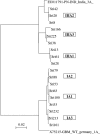Clinical Features and Transmission Pattern of Hepatitis A: An Experience from a Hepatitis A Outbreak Caused by Two Cocirculating Genotypes in Sri Lanka
- PMID: 27382079
- PMCID: PMC5062799
- DOI: 10.4269/ajtmh.16-0221
Clinical Features and Transmission Pattern of Hepatitis A: An Experience from a Hepatitis A Outbreak Caused by Two Cocirculating Genotypes in Sri Lanka
Abstract
Sri Lanka is one of the intermediate-endemic areas for hepatitis A virus (HAV), and concerns exist about the increasing HAV-susceptible population. In fact, Sri Lanka recorded a large hepatitis outbreak, possibly hepatitis A, around the end of the Sri Lankan war. It included more than 14,000 patients consisting of local residents, internally displaced personnel, and military personnel in the main combat zone. The outbreak had slowed down by October 2009; however, acute viral hepatitis continued to occur sequentially among military personnel. We obtained clinical information and serum samples from 222 patients with acute hepatitis who visited the Military Hospital Anuradhapura between January and September 2010. Samples were subjected to laboratory testing including HAV-immunoglobulin M and genotyping. Most patients (98.2%) were confirmed as having hepatitis A belonging to two subgenotypes: IA and IIIA. We did not observe any differences in clinical or biochemical features among patients with subgenotypes IA and IIIA except for pale stools and upper abdominal discomfort. During the investigation period, we observed a serial outbreak caused by identical HAV strains with an interval in line with that of typical HAV incubation periods. Most patients in the first outbreak were found in the training center, and patients in the second outbreak were found in multiple places where soldiers were assigned after the training center. These findings indicate that a strain of HAV diffused from one place to another along with movement of infected persons among the HAV-susceptible population. HAV vaccination for high-risk groups, such as young soldiers, is necessary.
© The American Society of Tropical Medicine and Hygiene.
Figures




Similar articles
-
A waterborne outbreak involving hepatitis A virus genotype IA at a residential facility in the Republic of Korea in 2015.J Clin Virol. 2017 Sep;94:63-66. doi: 10.1016/j.jcv.2017.07.006. Epub 2017 Jul 14. J Clin Virol. 2017. PMID: 28759774
-
Clinical features and molecular characterization of hepatitis A virus outbreak in a child care center in Thailand.J Clin Virol. 2005 Jan;32(1):24-8. doi: 10.1016/j.jcv.2004.04.008. J Clin Virol. 2005. PMID: 15572002
-
The important role of early diagnosis and preventive management during a large-scale outbreak of hepatitis A in Thailand.Pathog Glob Health. 2013 Oct;107(7):367-72. doi: 10.1179/2047773213Y.0000000116. Epub 2013 Dec 19. Pathog Glob Health. 2013. PMID: 24392680 Free PMC article.
-
Hepatitis a virus genotypes and strains from an endemic area of Europe, Bulgaria 2012-2014.BMC Infect Dis. 2017 Jul 14;17(1):497. doi: 10.1186/s12879-017-2596-1. BMC Infect Dis. 2017. PMID: 28705178 Free PMC article.
-
Hepatitis A virus: host interactions, molecular epidemiology and evolution.Infect Genet Evol. 2014 Jan;21:227-43. doi: 10.1016/j.meegid.2013.10.023. Epub 2013 Nov 5. Infect Genet Evol. 2014. PMID: 24200587 Review.
Cited by
-
Liver Disease in Sri Lanka.Euroasian J Hepatogastroenterol. 2017 Jan-Jun;7(1):78-81. doi: 10.5005/jp-journals-10018-1217. Epub 2017 May 5. Euroasian J Hepatogastroenterol. 2017. PMID: 29201778 Free PMC article. Review.
-
Increasing Burden of Hepatitis A in Adolescents and Adults and the Need for Long-Term Protection: A Review from the Indian Subcontinent.Infect Dis Ther. 2019 Dec;8(4):483-497. doi: 10.1007/s40121-019-00270-9. Epub 2019 Nov 2. Infect Dis Ther. 2019. PMID: 31679118 Free PMC article. Review.
-
The military as a neglected pathogen transmitter, from the nineteenth century to COVID-19: a systematic review.Glob Health Res Policy. 2021 Dec 10;6(1):48. doi: 10.1186/s41256-021-00232-0. Glob Health Res Policy. 2021. PMID: 34893071 Free PMC article.
-
Hepatitis A virus infection and hepatitis A vaccination in human immunodeficiency virus-positive patients: A review.World J Gastroenterol. 2017 May 28;23(20):3589-3606. doi: 10.3748/wjg.v23.i20.3589. World J Gastroenterol. 2017. PMID: 28611512 Free PMC article. Review.
References
-
- Hollinger FB, Emerson SU. Hepatitis A virus. In: Knipe DM, Howley PM, editors. Fields Virology. 5th edition. Philadelphia, PA: Lippincott Williams and Wilkins; 2007. pp. 911–947.
-
- World Health Organization Department of Communicable Disease Surveillance and Response Hepatitis A. 2000. http://www.who.int/csr/disease/hepatitis/whocdscsredc2007/en/index.html Available at. Accessed September 28, 2015.
-
- Lemon SM, Jansen RW, Brown EA. Genetic, antigenic and biological differences between strains of hepatitis A virus. Vaccine. 1992;10:S40–S44. - PubMed
-
- Koff RS. Clinical manifestations and diagnosis of hepatitis A virus infection. Vaccine. 1992;10:S15–S17. - PubMed
-
- World Health Organization WHO position paper on hepatitis A vaccine: June 2012. Wkly Epidemiol Rec. 2012;87:261–276. - PubMed
MeSH terms
Substances
LinkOut - more resources
Full Text Sources
Other Literature Sources
Medical

